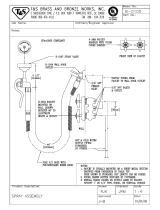
15
Installation Instructions.
RINSE OUT CARBON FINES
Small particles of carbon filtration material are
generated during manufacturing and shipping.
These particles will exit the media tank with the
first water that flows through the softener. These
carbon “fines” are not harmful, but give the water
a gray color and should be rinsed down the drain
before any water from the softener is directed to
the home’s faucets or water heater.
CAUTION: To avoid water or air pressure damage
to softener inner parts, and to flush carbon fines,
pipe chips or other residue from the water pipes,
be sure to do the following steps exactly as
instructed.
1. Make sure the softener’s valve drain hose is
hooked up and the open end directed to a floor
drain, laundry tube or other suitable type of
drain.
2. The system should be connected to electrical
power.
3. Place the bypass valve in “bypass” position
(see Figure 4). On a single valve, slide the stem
inward to bypass. On a 3-valve bypass, close
the inlet and outlet valves and open the bypass
valve.
4. Fully open the house main water pipe shutoff
valve.
5. Initiate a regeneration by pressing and holding
for 3 seconds the RECHARGE button. The valve
motor will start running and the valve will
advance to the “Fill” position (see Figure 21).
6. After you hear the valve motor stop running
(valve in “Fill” position), press, but do not hold
the RECHARGE button. The valve will advance
to the “Brine” position (see Figure 21).
7. After you hear the valve motor stop running
(valve in “Brine” position), press, but do not hold
the RECHARGE button. The valve will advance
to the “Backwash” position (see Figure 21).
8. Once the unit is in the backwash, place bypass
valve in SERVICE position (see Figure 4), exactly
as follows:
(a). Single Bypass Valve: Slowly, slide pull the
valve stem outward toward service, pausing
several times to allow the softener to pressurize
gradually. Check for leaks.
(b). 3-Valve Bypass: Fully close the bypass
valve and open the outlet valve. Slowly open
the inlet valve, pausing several time to allow
the softener to pressurize gradually. Check for
leaks.
9. Let the softener complete the backwash and
fast rinse cycles (takes about 20 minutes).
When the regeneration ends, the softener’s
valve returns to the service position.
TEST FOR LEAKS
To prevent air pressure in the water softener and
plumbing system, complete the following steps in
order:
1. Fully open two or more softened cold water
faucets close to the water softener, located
down stream from the water softener.
2. Observe steady water flow from both open
faucets.
3. After about three minutes, open a hot water
faucet until there is a steady flow and there are
no air bubbles, then close this faucet.
4. Close all cold water faucets and check for leaks
at the plumbing connections that you made.
5. Check for leaks around clips at softener’s
inlet and outlet. If a leak occurs at a clip,
depressurize the plumbing (turn off the water
supply and open faucets) before removing clip.
When removing clips at the softener’s inlet
or outlet, push the single bypass valve body
toward the softener (see Figure 14). Improper
removal may damage clips. Do not reinstall
damaged clips.
NOTE: If this procedure is performed on a new
softener, water coming from the taps may
initially be discolored. This normally occurs
the first time water runs through the resin bed.
The discoloration will not last more than a few
minutes.
Figure 14
....depressurize the
plumbing, then push
Bypass Valve body
toward softener
If removing
clips.....
















